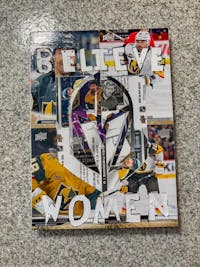Rose brings students into the world of acquiring art with gallery talk
A rare and intimate look at the process and stories behind the acquisition of paintings in the "In the Spotlight" exhibit was the focus of the tour and talk at the Rose Art Museum on Saturday. Director Joseph Ketner lead the mid-afternoon tour of approximately 25 community members, artists and students around main gallery, explaining the selection of some of the most "appealing" works collected by the Rose in the last five to six years. Representing only a small portion of the museum's most recent acquisitions, the exhibit features modern and post-modern paintings and photography. The exhibit will be extended for the Festival of the Arts until May 2, 2004. Through purchases, gifts and benefactors, the pieces acquired in the exhibit are not meant to be a historical survey but rather clusters of art organized by artist, genre and time period of the work.
Ketner started the program with fascinating background on how Brandeis and the Rose approach the process of collecting art, noting that the tour would concentrate on the "how" rather than on the paintings themselves. Yet regardless much insight on the techniques and methods behind the paintings was shared throughout the 50 minute tour. The nature of collecting things, a Western notion of gathering that Ketner explained is inherent in us all, manifests itself through the collections and piles of belongings we hoard in our own homes. The museum is similar in that sense, yet "Institutional gathering is a little more thoughtful than that," Ketner said.
Ketner prides the museum on its "small but excellent" approach, seemingly modeled after the Kimball Museum in Texas, which Ketner explained is a "modest scale museum [where] every single object is a masterpiece." The Rose, similar to the Kimball, is a successful attempt to avoid the dreaded and too commonplace "visual burn out" of large scale museums, where you end up dragging yourself out the door.
The tour began with a look at four pieces by David Reed, who was described by Ketner as the "painter's painter" and highly regarded within the art community in the 1960's and 70's. While Reed's paintings look abstract and spontaneous, characterized by large brush strokes and bold splotches, his methodological way of dissecting paintings is demonstrated through each stroke of paint. Spanning months at a time, the process is actually quite laborious and involves painting, scraping off the paint, and systematically repainting. All of Reed's paintings are numbered instead of titled and beside number "four hundred something" (the exact number is unknown due to mislabeling technicalities), the
Rose has displayed Reeds bold and dark painting titled #1, allowing viewers to see how the artist has grown and evolved over the years.
One of the most striking and interesting paintings in the exhibit is Tim Rollins and Kids of Survival's (K.O.S.) "The Interior of the Heart" ('87). Spanning the length of the wall, the painting includes actual pages of the famous novel "The Scarlet Letter", with four large, deeply toned, maroon A's painted on top of the collaged pages. In the 1980's, Rollins started K.O.S, a program for public school children encouraging them to read a book and then use the pages of the novel and paint to create such works of art similar to the one in the museum. Generously, a percentage of the profit Rollins receives from his similar themed paintings goes back to the school system.
Downstairs, the tour's focus turned to modern photography including the works of Matthew Barney, Richard Prince and Thomas Ruff. Through its bold colors and risqu metaphors, Matthew Barney's Cremaster series challenges viewers to consider bizarre statements on sexuality and gender. Five photographs are situated horizontally across the wall. The photographs are images of individuals, or rather creatures, from the dream-like and disturbing Cremaster film series created by Barney. The first features a famous skater elegantly and cinematically posed, and the second is reminiscent of a mug shot. The most arresting piece in the entire exhibit is the third in the series, a disturbing photo of a powdered painted man wearing pink shag with bloodied material protruding from his mouth and framed by a striking turquoise backdrop. Next is a goat-like figure covered in molten wax, and the series finishes with a delicate photo of a woman covered by a black veil.
Barney studied at Yale to be a doctor before pursuing art, and it is obvious this influence transfers onto his art as such physiological aspects as organs and biological themes are seen in his work. Ketner described them as a unique set of metaphors that produce new creationist myths and that are a little "sick and bizarre" to the point where they compromise beauty. But the photos draw on the contradictions that press buttons and make us, as viewers, ask questions.
The goal is for the institution to become an "encyclopedia of visual history." When Ketner arrived at Brandeis, he felt the things found in the storage room were extraordinary. There were hundreds of pieces that could not be displayed because of challenge that directors of the museums are constantly faced with: how to effectively display all the museum's acquisitions. Ketner and the rest of the Rose Art museum staff have meet this challenge with "In the Spotlight," highlighting some of the most challenging and stimulating pieces the museum has to offer.



Please note All comments are eligible for publication in The Justice.